Removal of Crystal Violet by Using Reduced-Graphene-Oxide-Supported Bimetallic Fe/Ni Nanoparticles (rGO/Fe/Ni): Application of Artificial Intelligence Modeling for the Optimization Process
Abstract
:1. Introduction
2. Experimental Section
2.1. Materials
2.2. Preparation of the Nanomaterials
2.2.1. Synthesis of GO
2.2.2. Synthesis of Fe/Ni Nanoparticles and rGO/Fe/Ni Composites
2.3. Characterization of the Prepared Nanomaterials
2.4. Determination of the Zero Point of Charge
2.5. Experiments
2.6. Optimization of Operating Parameters
2.6.1. Box–Behnken Design (BBD)
2.6.2. ANN Modeling
2.6.3. Optimization Using ANN-GA and ANN-PSO Models
3. Results and Discussion
3.1. Characterization of Fe/Ni Nanoparticles and rGO/Fe/Ni Composites
3.2. The Zero Point of Charge of rGO/Fe/Ni Composites
3.3. Experimental Results
3.4. BP-ANN Model
3.5. Prediction by BBD, ANN-PSO, and ANN-GA
3.6. Isotherm Studies
3.7. Kinetics Studies
3.8. Thermodynamics Studies
4. Conclusions
Author Contributions
Funding
Conflicts of Interest
References
- Miyah, Y.; Lahrichi, A.; Idrissi, M.; Boujraf, S.; Taouda, H.; Zerrouq, F. Assessment of adsorption kinetics for removal potential of crystal violet dye from aqueous solutions using Moroccan pyrophyllite. J. Assoc. Arab Univ. Basic Appl. Sci. 2017, 23, 20–28. [Google Scholar] [CrossRef]
- Rehman, F.; SAayed, M.; Khan, J.A.; Khan, H.M. Removal of crystal violet dye from aqueous solution by gamma irradiation. J. Chil. Chem. Soc. 2017, 62, 3359–3364. [Google Scholar] [CrossRef]
- Tripathy, N.; Ahmad, R.; Song, J.E.; Park, H.; Khang, G. ZnO nanonails for photocatalytic degradation of crystal violet dye under UV irradiation. Mater. Sci. 2017, 4, 267–276. [Google Scholar] [CrossRef]
- Kulkarni, M.R.; Revanth, T.; Acharya, A.; Bhat, P. Removal of crystal violet dye from aqueous solution using water hyacinth: Equilibrium, kinetics and thermodynamics study. Resour.-Effic. Technol. 2017, 3, 71–77. [Google Scholar] [CrossRef]
- Benjelloun, Y.; Lahrichi, A.; Boumchita, S.; Idrissi, M.; Miyah, Y.; Anis, Kh.; Nenov, V.; Zerrouq, F. Removal of crystal violet by wet oxidation with H2O2 over an Iron oxide catalyst synthesized from fly ash. J. Mater. Environ. Sci. 2017, 8, 2259–2269. [Google Scholar]
- Bazzoa, A.; Adebayob, M.A.; Diasa, S.L.P.; Limaa, E.C.; Vaghettia, J.C.P.; de Oliveiraa, E.R.; Leitea, A.J.B.; Pavanc, F.A. Avocado seed powder: Characterization and its application for crystal violet dye removal from aqueous solutions. Desalination Water Treat. 2015, 57, 1–16. [Google Scholar] [CrossRef]
- Oladipo, A.A.; Gazi, M. Enhanced removal of crystal violet by low cost alginate/acid activated bentonite composite beads: Optimization and modelling using non-linear regression technique. J. Water Process Eng. 2014, 2, 43–52. [Google Scholar] [CrossRef]
- Bosson, J.; Gouin, J.; Lacour, J. Cationic triangulenes and helicenes: Synthesis, chemical stability, optical properties and extended applications of these unusual dyes. Chem. Soc. Rev. 2014, 43, 2824–2840. [Google Scholar] [CrossRef] [PubMed]
- Sudamalla, P.; Saravanan, P.; Matheswaran, M. Optimization of operating parameters using response surface methodology for adsorption of crystal violet by activated carbon prepared from mango kernel. Environ. Res. 2012, 22, 1–7. [Google Scholar]
- Choi, K.; Lee, W. Enhanced degradation of trichloroethylene in nano-scalezero-valent iron Fenton system with Cu(II). J. Hazard. Mater. 2012, 99, 146–153. [Google Scholar] [CrossRef] [PubMed]
- Yin, W.; Wu, J.; Li, P.; Wang, X.; Zhu, N.; Wu, P.; Yang, B. Experimental study ofzero-valent iron induced nitrobenzene reduction in groundwater: The effects of pH, iron dosage, oxygen and common dissolved anions. Chem. Eng. J. 2012, 184, 198–204. [Google Scholar] [CrossRef]
- Fan, M.Y.; Li, T.J.; Hu, J.W.; Cao, R.S.; Wu, Q.; Wei, X.H.; Li, L.Y.; Shi, X.D.; Ruan, W.Q. Synthesis and characterization of reduced graphene oxide-supported nanoscale zero-valent iron (nZVI/rGO) composites used for Pb(II) removal. Materials 2016, 9, 687. [Google Scholar] [CrossRef] [PubMed]
- Luo, S.; Qin, P.; Shao, J.; Peng, L.; Zeng, Q.; Gu, J.D. Synthesis of reactive nanoscalezero valent iron using rectorite supports and its application for Orange II removal. Chem. Eng. J. 2013, 223, 1–7. [Google Scholar] [CrossRef]
- Segura, Y.; Martínez, F.; Melero, J.A.; Molina, R.; Chand, R.; Bremner, D.H. Enhance-ment of the advanced Fenton process (Fe0/H2O2) by ultrasound for themineralization of phenol. Appl. Catal. B Environ. 2012, 113–114, 100–106. [Google Scholar] [CrossRef]
- Li, L.Y.; Hu, J.W.; Shi, X.D.; Fan, M.Y.; Luo, J.; Wei, X.H. Nanoscale zero-valent metals: A review of synthesis, characterization, and applications to environmental remediation. Environ. Sci. Pollut. Res. 2016, 23, 17880–17900. [Google Scholar] [CrossRef] [PubMed]
- Eda, B.G.; Chhowalla, M. Chemically derived graphene oxide: Towards large-area thin-film electronics and optoelectronics. Adv. Mater. 2010, 22, 2392–2415. [Google Scholar] [CrossRef] [PubMed]
- Dreyer, D.R.; Park, S.; Bielawski, C.W.; Ruoff, R.S. The chemistry of graphene oxide. Chem. Soc. Rev. 2010, 39, 228–240. [Google Scholar] [CrossRef] [PubMed]
- Zhou, S.; Bongiorno, A. Density functional theory modeling of multilayer “epitaxial” graphene oxide. Acc. Chem. Res. 2014, 47, 3331–3339. [Google Scholar] [CrossRef] [PubMed]
- Hu, L.; Hu, X.; Wu, X.; Du, C.; Dai, Y.C.; Deng, J.B. Density functional calculation of transition metal adatom adsorption on graphene. Phys. B Condens. Matter 2010, 405, 3337–3341. [Google Scholar] [CrossRef]
- Dimakis, N.; Flor, F.A.; Salgado, A.; Adjibi, K.; Vargas, S.; Saenz, J. Density functional theory calculations on transition metal atoms adsorbed on graphene monolayers. Appl. Surf. Sci. 2016, 421, 252–259. [Google Scholar] [CrossRef]
- Nakada, K.; Ishii, A. DFT Calculation for adatom adsorption on graphene. In Graphene Simulation; InTech: Rijeka, Croatia, 2011. [Google Scholar]
- Dimakis, N.; Navarro, N.E.; Velazquez, J.; Salgado, A. Electronic and vibrational properties of graphene monolayers with iron adatoms: A density functional theory study. Appl. Surf. Sci. 2015, 334, 2–6. [Google Scholar] [CrossRef]
- Chan, K.T.; Neaton, J.B.; Cohen, M.L. First-principles study of metal adatom adsorption on graphene. Phys. Rev. B Condens. Matter 2008, 77, 1–12. [Google Scholar] [CrossRef]
- Mazaheri, H.; Ghaedi, M.; Azqhandi, M.H.A.; Asfarama, A. Application of machine/statistical learning, artificial intelligence and statistical experimental design for the modeling and optimization of methylene blue and Cd(II) removal from a binary aqueous solution by natural walnut carbon. Phys. Chem. Chem. Phys. 2017, 19, 11299–11317. [Google Scholar] [CrossRef] [PubMed]
- Najafi, F.; Moradi, O.; Rajabi, M.; Asif, M.; Tyagi, I.; Agarwal, S. Gupta, V.K. Thermodynamics of the adsorption of nickel ions from aqueous phase using graphene oxide and glycine functionalized graphene oxide. J. Mol. Liq. 2015, 208, 106–113. [Google Scholar] [CrossRef]
- Robati, D.; Mirza, B.; Rajabi, M.; Moradi, O.; Tyagi, I.; Agarwal, S.; Gupta, V. Removal of hazardous dyes-BR 12 and methyl orange using graphene oxide as an adsorbent from aqueous phase. Chem. Eng. J. 2016, 284, 687–697. [Google Scholar] [CrossRef]
- Fan, M.Y.; Hu, J.W.; Cao, R.S.; Ruan, W.Q.; Wei, X.H. A review on experimental design for pollutants removal in water treatment with the aid of artificial intelligence. Chemsphere 2018, 2, 111. [Google Scholar] [CrossRef] [PubMed]
- Rajendra, M.; Jena, P.C.; Raheman, H. Prediction of optimized pretreatment process parameters for biodiesel production using ANN and GA. Fuel 2009, 88, 868–875. [Google Scholar] [CrossRef]
- Gordan, B.; Armaghani, D.J.; Hajihassani, M.; Monjezi, M. Prediction of seismic slope stability through combination of particle swarm optimization and neural network. Eng. Comput. 2016, 2, 85–97. [Google Scholar] [CrossRef]
- Hummers, W.S.; Offeman, R.E. Preparation of graphitic oxide. J. Am. Chem. Soc. 1958, 80, 1339. [Google Scholar] [CrossRef]
- Kang, H.Y.; Xiu, Z.M.; Chen, J.W.; Cao, W.P.; Guo, Y.F.; Li, T.L.; Jin, Z.H. Reduction of nitrate by bimetallic Fe/Ni nanoparticles. Environ. Technol. 2012, 33, 2185–2192. [Google Scholar] [CrossRef] [PubMed]
- Ghaedi, A.M.; Ghaedi, M.; Pouranfard, A.R.; Ansari, A.; Avazzadeh, Z.; Vafaei, A.; Tyagi, I.; Agarwal, S.; Gupta, V.K. Adsorption of triamterene on multi-walled and single-walled carbon nanotubes: Artificial neural network modeling and genetic algorithm optimization. J. Mol. Liq. 2016, 216, 654–665. [Google Scholar] [CrossRef]
- Zehra, T.; Priyantha, N.; Lim, L.B.L.; Iqbal, E. Sorption characteristics of peat of Brunei Darussalam V: 535 removal of Congo red dye from aqueous solution by peat. Desalination Water Treat. 2015, 54, 2592–2600. [Google Scholar] [CrossRef]
- Zhang, Y.Y.; Pan, B.C. Modeling batch and column phosphate removal by hydrated ferric oxide-based nanocomposite using response surface methodology and artificial neural network. Chem. Eng. J. 2014, 249, 111–120. [Google Scholar] [CrossRef]
- Mohana, S.; Singh, Y.; Verma, D.K.; Hasana, S.H. Synthesis of CuO nanoparticles through greenroute using Citrus limon juice and its application asnanosorbent for Cr(VI) remediation: Processoptimization with RSM and ANN-GA based model. Process Saf. Environ. Prot. 2015, 96, 156–166. [Google Scholar] [CrossRef]
- Ruan, W.Q.; Shi, X.D.; Hu, J.W.; Hou, Y.; Fan, M.Y.; Cao, R.S.; Wei, X.H. Modeling of Malachite Green Removal from aqueous solutions by nanoscale zerovalent zinc using artificial neural network. Appl. Sci. 2017, 8, 3. [Google Scholar] [CrossRef]
- Montano, J.J.; Palmer, A. Numeric sensitivity analysis applied to feedforward neural networks. Neural Comput. Appl. 2003, 12, 119–125. [Google Scholar] [CrossRef]
- Fan, M.Y.; Hu, J.W.; Cao, R.S.; Xiong, K.N.; Wei, X.H. Modeling and prediction of copper removal from aqueous solutions by nZVI/rGO magnetic nanocomposites using ANN-GA and ANN-PSO. Sci. Rep. 2017, 7, 18040. [Google Scholar] [CrossRef] [PubMed]
- Kennedy, J.; Spears, W.M. Matching algorithms to problems: An experimental test of the particle swarm and some genetic algorithms on the multimodal problem generator. In Proceedings of the IEEE Int’l Conference on Evolutionary Computation, Anchorage, AK, USA, 4–9 May 1998; pp. 78–83. [Google Scholar]
- Samanta, B.; Al-Balushi, K.R.; Al-Araimi, S.A. Bearing fault detection using artificial neural networks and genetic algorithm. Soft Comput. 2004, 3, 1–12. [Google Scholar] [CrossRef]
- Shi, X.D.; Ruan, W.Q.; Hu, J.W.; Fan, M.Y.; Cao, R.S.; Wei, X.H. Optimizing the removal of rhodamine B in aqueous solutions by reduced graphene oxide-supported nanoscale zerovalent iron (nZVI/rGO) using an artificial neural network-genetic algorithm (ANN-GA). Nanomaterials 2017, 7, 309. [Google Scholar] [CrossRef]
- Eberhart, R.C.; Kennedy, J. A new optimizer using particle swarm theory. In Proceedings of the 6th International Symposium on Micromachine and Human Science, Nagoya, Japan, 4–6 October 1995; pp. 39–43. [Google Scholar]
- Sahu, R.S.; Li, D.L.; Doong, R. Unveiling the hydrodechlorination of trichloroethylene by reduced graphene oxide supported bimetallic Fe/Ni nanoparticles. Chem. Eng. J. 2018, 334, 30–40. [Google Scholar] [CrossRef]
- Wang, W.; Ji, Z.; Li, T.; Zhang, H.; Gao, S. Preparation of spherical iron nanoclusters in ethanol-water solution for nitrate removal. Chemosphere 2006, 65, 1396–1404. [Google Scholar] [CrossRef] [PubMed]
- Sahu, R.S.; Bindumadhavan, K.; Doong, R.A. Boron-doped reduced graphene oxidebased bimetallic Ni/Fe nanohybrids for the rapid dechlorination of trichloroethylene. Environ. Sci. Nano 2017, 4, 565–576. [Google Scholar] [CrossRef]
- Kumar, N.A.; Nolan, H.; McEvoy, N.; Rezvani, E.; Doyle, R.; Lyons, M.E.G.; Duesberg, G.S. Plasma-assisted simultaneous reduction and nitrogen doping of graphene oxide nanosheets. J. Mater. Chem. A 2013, 1, 4431–4435. [Google Scholar] [CrossRef]
- Bhunia, P.; Kim, G.; Baik, C.; Lee, H. A strategically designed porous iron-iron oxide matrix on graphene for heavy metal adsorption. Chem. Commun. 2012, 48, 9888–9890. [Google Scholar] [CrossRef] [PubMed]
- Li, B.J.; Cao, H.Q.; Yin, G.; Lu, Y.X.; Yin, J.F. Cu2O@reduced graphene oxide composite for removal of contaminants from water and supercapacitor. J. Mater. Chem. 2011, 21, 10645–10648. [Google Scholar] [CrossRef]
- Ahmad, M.A.; Alrozi, R. Removal of malachite green dye from aqueous solution using rambutan peel-based activated carbon: Equilibrium, kinetic and thermodynamic studies. Chem. Eng. J. 2011, 171, 510–516. [Google Scholar] [CrossRef]
- Ashrafi, S.D.; Kamani, H.; Jaafari, J.; Mahvi, A.H. Experimental design and response surface modeling for optimization of fluoroquinolone removal from aqueous solution by NaOH-modified rice husk. Desalination Water Treat. 2016, 57, 16456–16465. [Google Scholar] [CrossRef]
- Langmuir, I. The adsorption of gases on plane surfaces of glass, mica and platinum. J. Am. Chem. Soc. 1918, 40, 1361–1403. [Google Scholar] [CrossRef]
- Hema, M.; Arivoli, S. Adsorption kinetics and thermodynamics of malachite green dye onto acid activated low cost carbon. J. Appl. Sci. Environ. Manag. 2008, 12, 43. [Google Scholar]
- Temkin, M.J.; Pyzhev, V. Recent modifications to Langmuir isotherms. Acta Physicochim. URSS 1940, 12, 217–222. [Google Scholar]
- Nur, S.; Abas, A.; Shah, H.; Siajam, S.I.; Kamal, M.L. Adsorption of Pb(II) ions by using mangrove-alginate composite beads(MACB): Isotherm, Kinetics and Thermodynamics studies. J. Purity Util. React. Environ. 2015, 4, 124–131. [Google Scholar]
- Gunay, A.; Arslankaya, E.; Tosun, I. Lead removal from aqueous solution by natural and pretreated clinoptilolite: Adsorption equilibrium and kinetics. J. Hazard. Mater. 2007, 146, 362–371. [Google Scholar] [CrossRef] [PubMed]
- Dabrowski, A. Adsorption—From theory to practice. Adv. Colloid Interface Sci. 2001, 93, 135–224. [Google Scholar] [CrossRef]
- Dubinin, M.M. The potential theory of adsorption of gases and vapors for adsorbents with energetically non-uniform surface. Chem. Rev. 1960, 60, 235–266. [Google Scholar] [CrossRef]
- Hobson, J.P. Physical adsorption isotherms extending from ultra-high vacuum to vapor pressure. J. Phys. Chem. 1969, 73, 2720–2727. [Google Scholar] [CrossRef]
- Banerjee, S.; Gautam, R.K.; Jaiswal, A.; Chattopadhyaya, M.C.; Sharma, Y.C. Rapid scavenging of methylene blue dye from a liquid phase by adsorption on alumina nanoparticles. RSC Adv. 2015, 5, 14425–14440. [Google Scholar] [CrossRef]
- Jiao, Q.; Qiu., F.X.; Rong, X.S.; Yan., J.; Zhao, H.; Yang, D.Y. Adsorption behavior of crystal violet from aqueous solutions with chitosan–graphite oxide modified polyurethane as an adsorbent. J. Appl. Polym. Sci. 2015, 132, 83–101. [Google Scholar]
- Islam, M.S.; Kusumoto, Y.; Kurawaki, J.; Abdulla-AL-Mamun, M.; Manaka, H. A comparative study on heat dissipation, morphological and magnetic properties of hyperthermia suitable nanoparticles prepared by co-precipitation and hydrothermal methods. Bull. Mater. Sci. 2012, 35, 1047–1053. [Google Scholar] [CrossRef]
- Javad, Z.; Maryam, B.; Tahere, S. Simultaneous removal of binary mixture of Brilliant Green and Crystal Violet using derivative spectrophotometric determination, multivariate optimization and adsorption characterization of dyes on surfactant modified nano-c-alumina. Spectrochim. Acta Mol. Biomol. Spectrosc. 2015, 137, 1016–1028. [Google Scholar]
- Ghorai, S.; Sarkar, A.; Raoufi, M.; Panda, A.B.; Schönherr, H.; Pal, S. Enhanced removal of methylene blue and methyl violet dyes from aqueous solution using a nanocomposite of hydrolyzed polyacrylamide grafted xanthan gum and incorporated nanosilica. ACS Appl. Mater. Interfaces 2014, 6, 4766–4777. [Google Scholar] [CrossRef] [PubMed]
- Bharath, G.; Alhseinat, E.; Ponpandian, N.; Khan, M.A.; Siddiqui, M.R.; Ahmed, F.; Alsharaeh, E.H. Development of adsorption and electrosorption techniques for removal of organic and inorganic pollutants from wastewater using novel magnetite/porous graphene-based nanocomposites. Sep. Purif. Technol. 2017, 188, 206–218. [Google Scholar] [CrossRef]
- Lagergren, S. Zur Theorie Der Sogenannten Adsorption Gelöster Stoffe. Bihang Till K Svenska Vet-Akad. Handlingar 1898, 24, 1–39. [Google Scholar]
- Ho, Y.S.; McKay, G. Sorption of dye from aqueous solution by peat. Chem. Eng. J. 1998, 70, 115–124. [Google Scholar] [CrossRef]
- Ho, Y.S.; McKay, G. Pseudo-second order model for sorption processes. Process Biochem. 1999, 4, 451–465. [Google Scholar] [CrossRef]
- Fan, M.Y.; Li, T.J.; Hu, J.W.; Cao, R.S.; Wei, X.H.; Shi, X.D.; Ruan, W.Q. Artificial neural network modeling and genetic algorithm optimization for cadmium removal from aqueous solutions by reduced graphene oxide-supported nanoscale zero-valent iron (nZVI/rGO) composites. Materials 2017, 10, 544. [Google Scholar] [CrossRef] [PubMed]
- Messina, P.V.; Schulz, P.C. Adsorption of reactive dyes on titaniasilica mesoporous materials. J. Colloid Interface Sci. 2006, 299, 305–320. [Google Scholar] [CrossRef] [PubMed]
- Akpomie, K.G.; Dawodu, F.A. Efficient abstraction of Ni(II) and Mn(II) ions from solution onto an alkaline modified montmorillonite. J. Taibah. Univ. Sci. 2014, 8, 343–356. [Google Scholar] [CrossRef]
- Haddad, M.E.; Slimani, R.; Mamouni, R.; ElAntri, S.; Lazar, S. Removal of two textile dyes from aqueous solutions onto calcined bones. J. Assoc. Arab Univ. Basic Appl. Sci. 2013, 14, 51–59. [Google Scholar] [CrossRef]
- Namasivayam, C.; Senthilkumar, S. Recycling of industrial solid waste for the removal of mercury (II) by adsorption process. Chemosphere 1997, 34, 357–375. [Google Scholar] [CrossRef]
- Wang, S.B.; Boyjoo, Y.; Choueib, A.; Zhu, Z.H. Removal of dyes from aqueous solution using fly ash and red mud. Water Res. 2005, 39, 129–138. [Google Scholar] [CrossRef] [PubMed]
- Sadaf, S.; Bhatti, H.N. Batch and fixed bed column studies for the removal of Indosol Yellow BG dye by peanut husk. J. Taiwan Inst. Chem. E. 2014, 45, 541–553. [Google Scholar] [CrossRef]
- Simone, M.S.; Klicia, A.S.; Roberta, C.; Roland, V.; Christian, S.; Wim, D.G.; Antonio, J.A.M. Adsorption of carotenes and phosphorus from palm oil onto acid activated bleaching earth: Equilibrium, kinetics and thermodynamics. J. Food Eng. 2013, 118, 341–349. [Google Scholar]

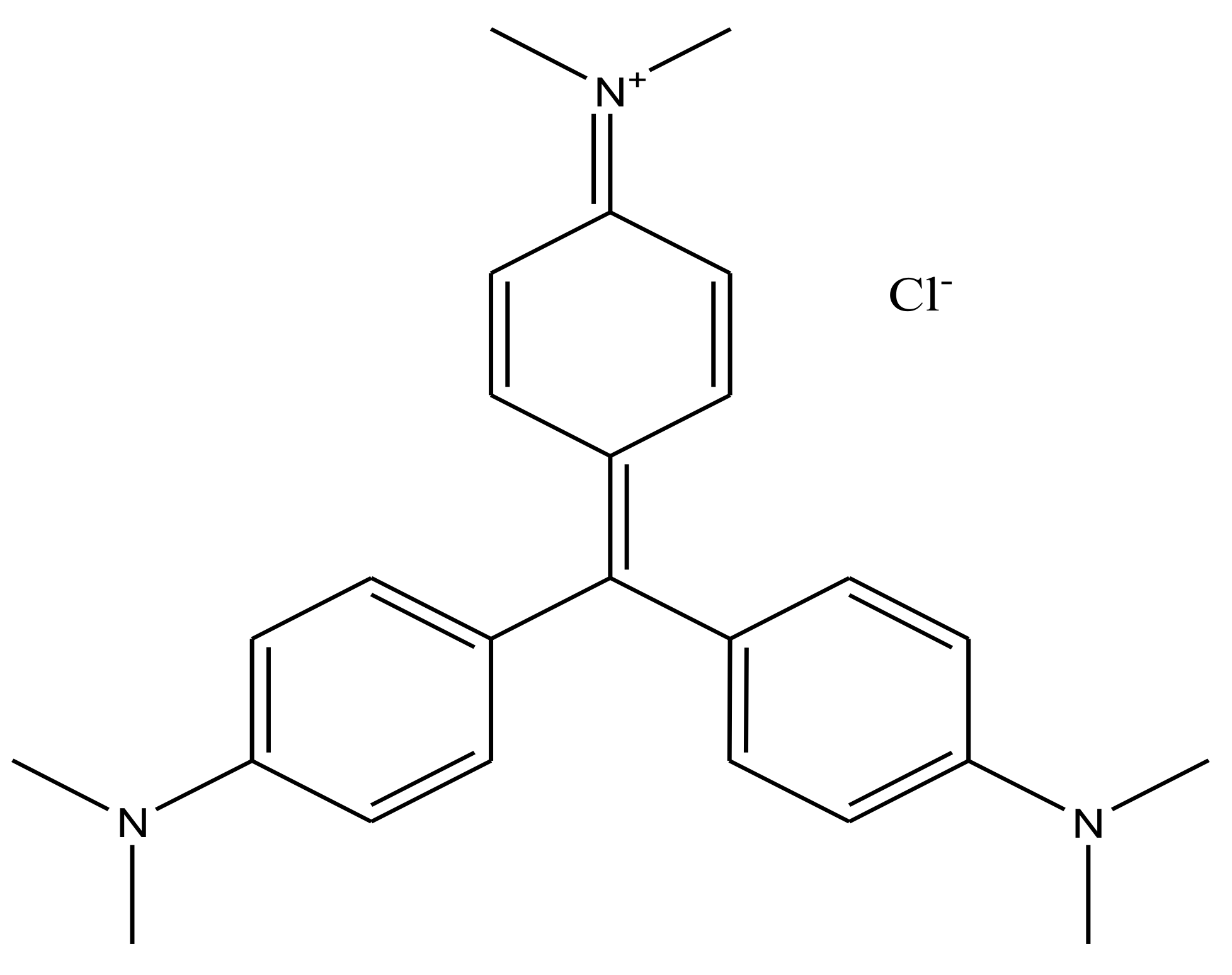
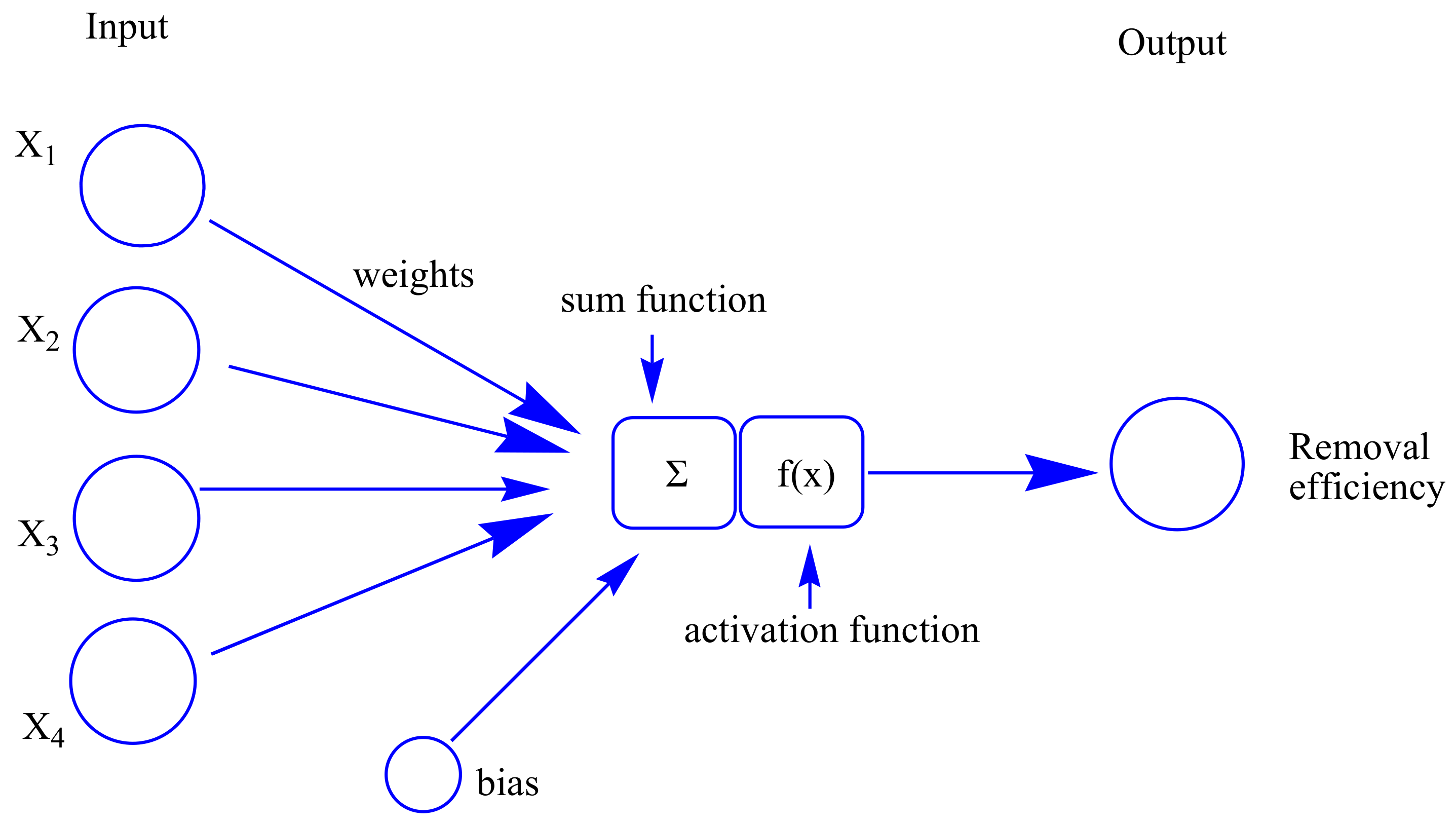
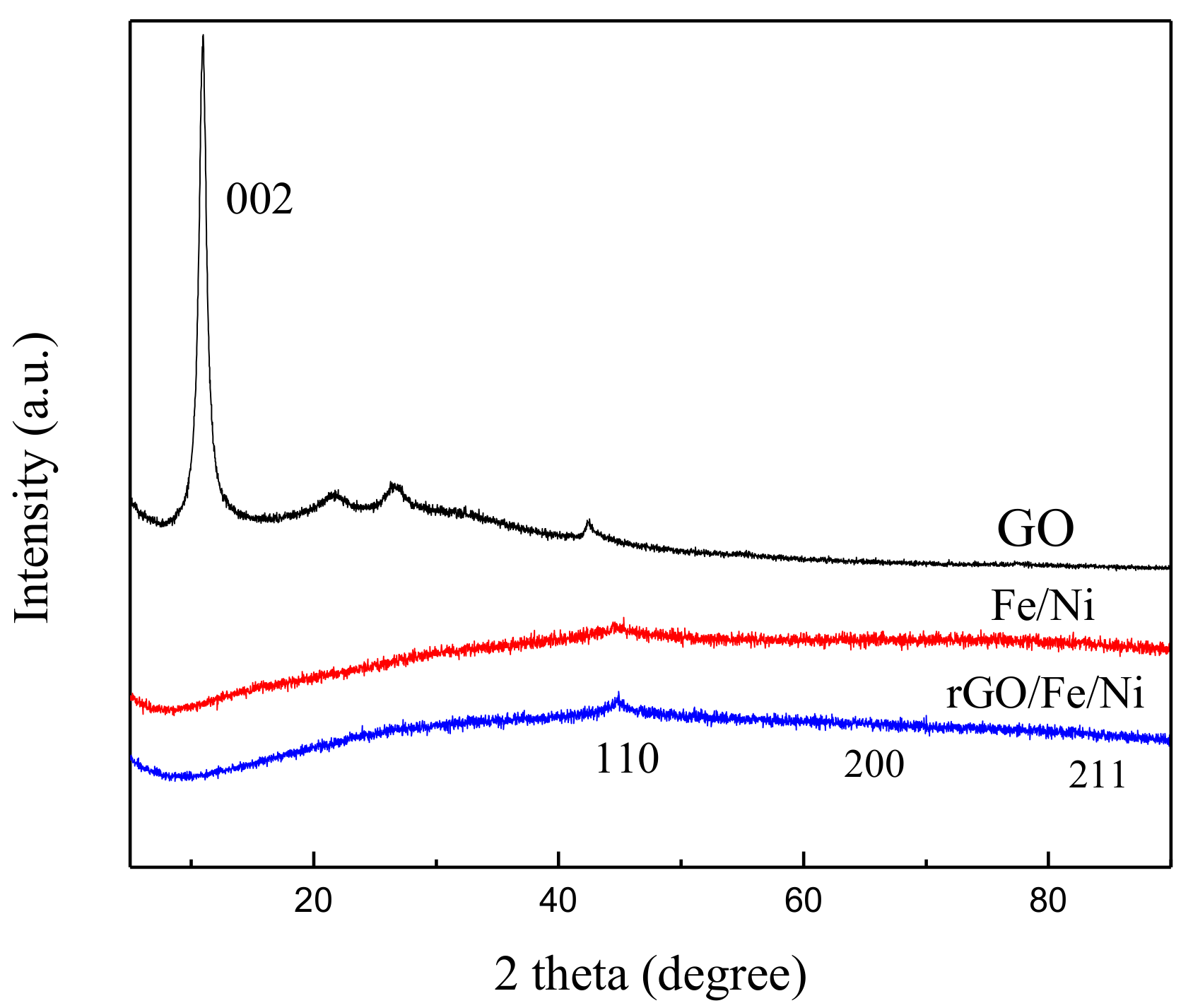
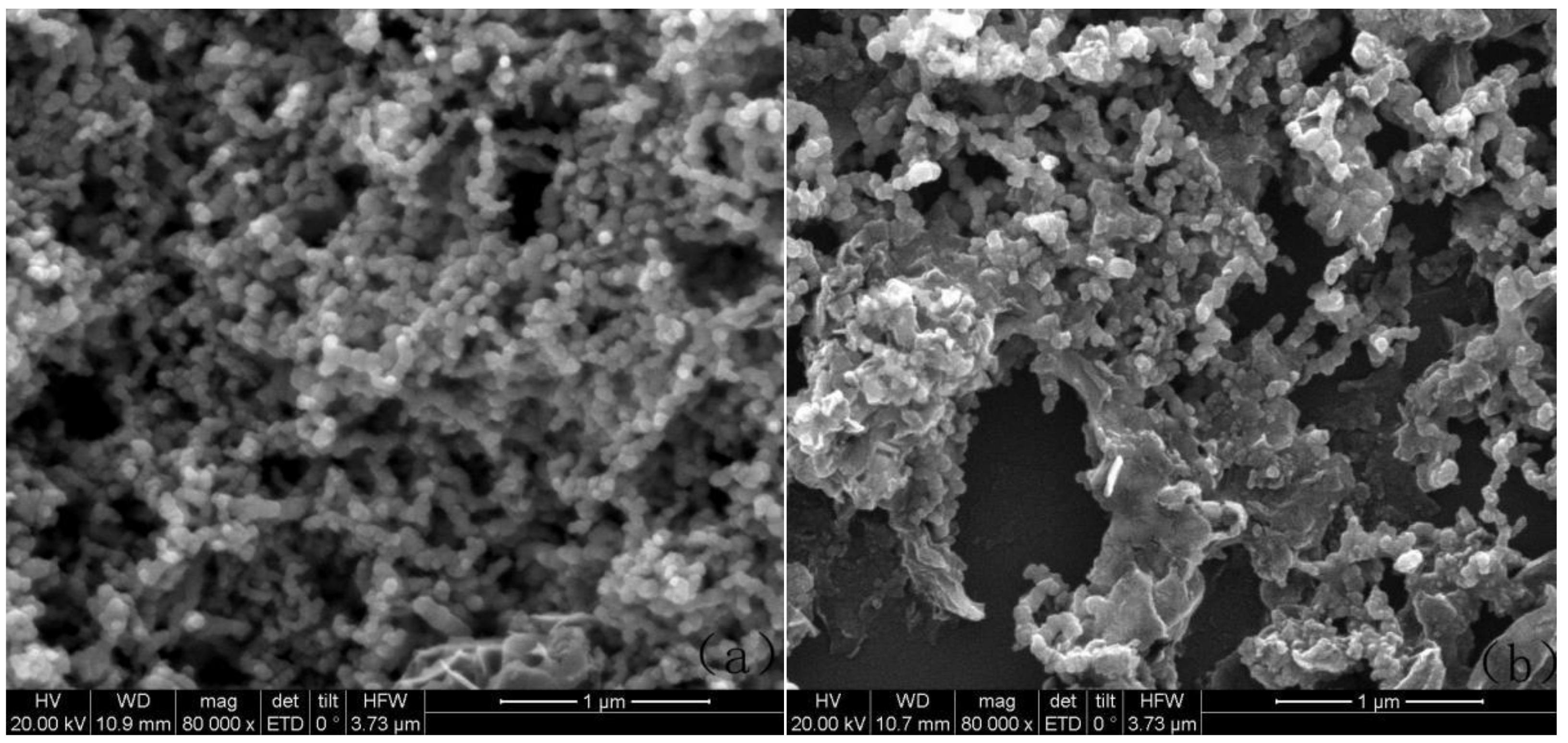
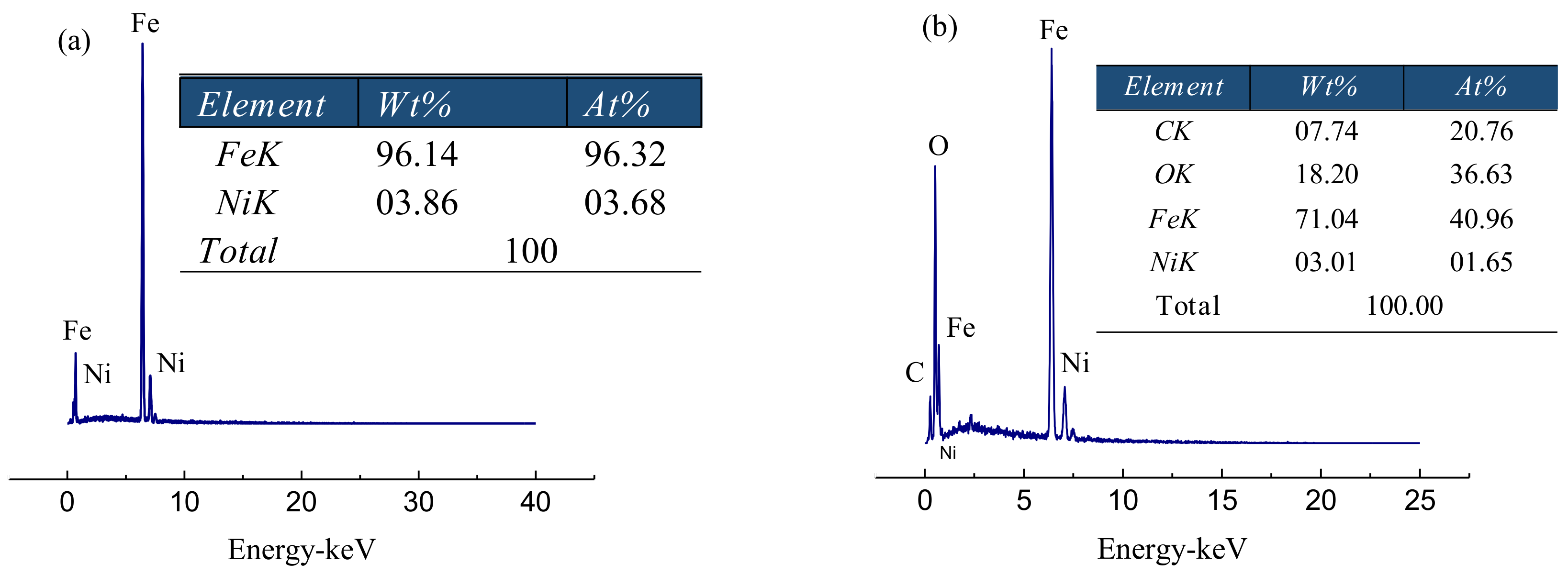
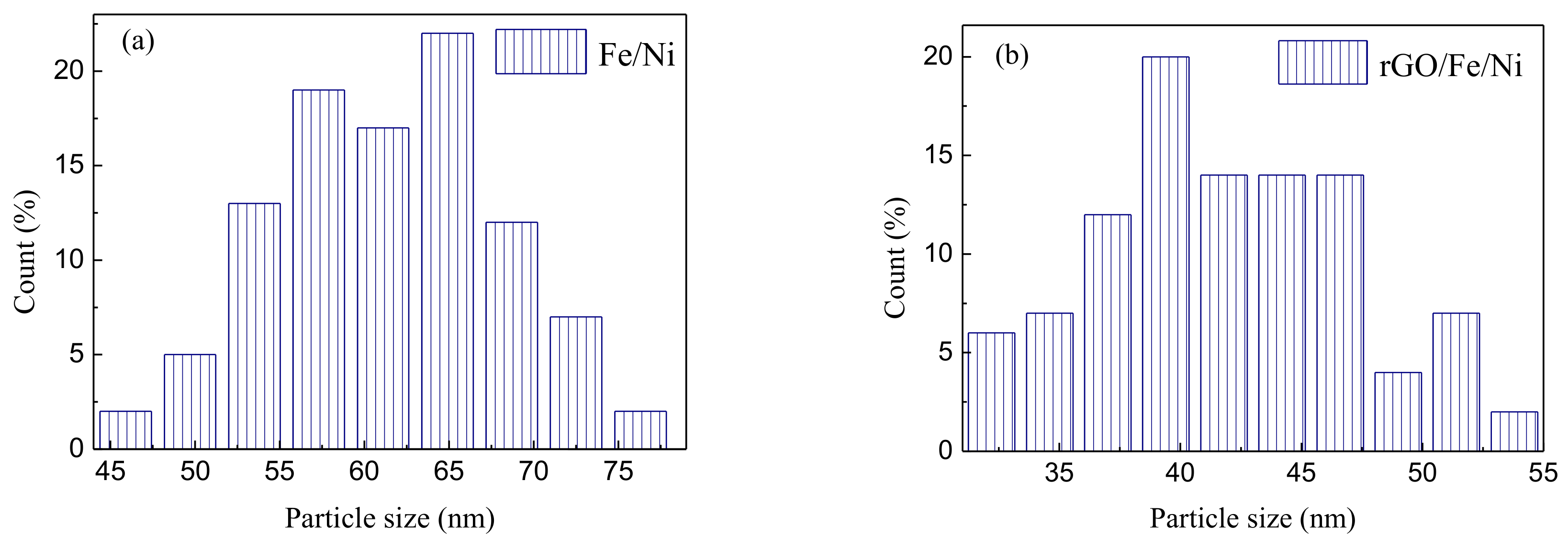
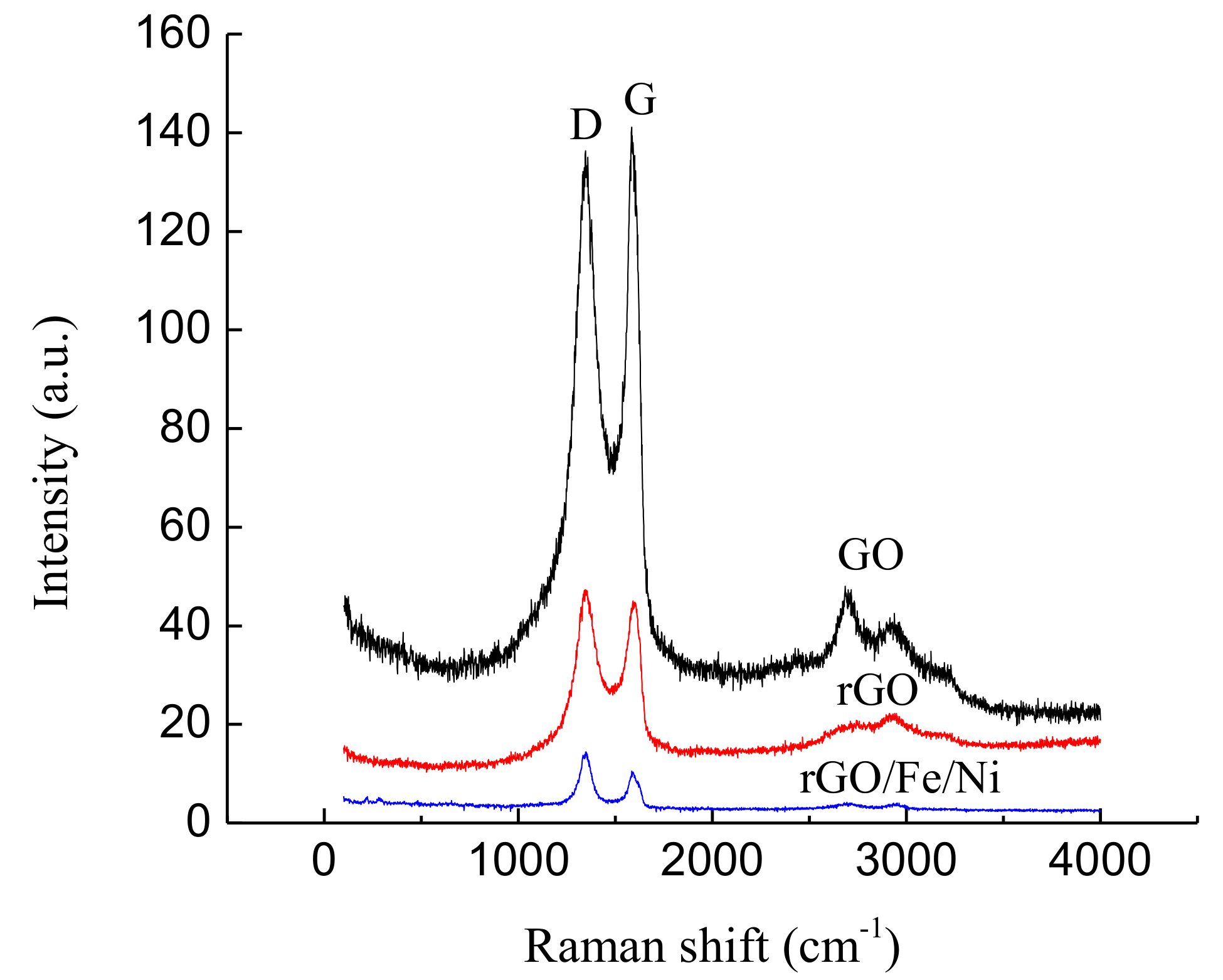
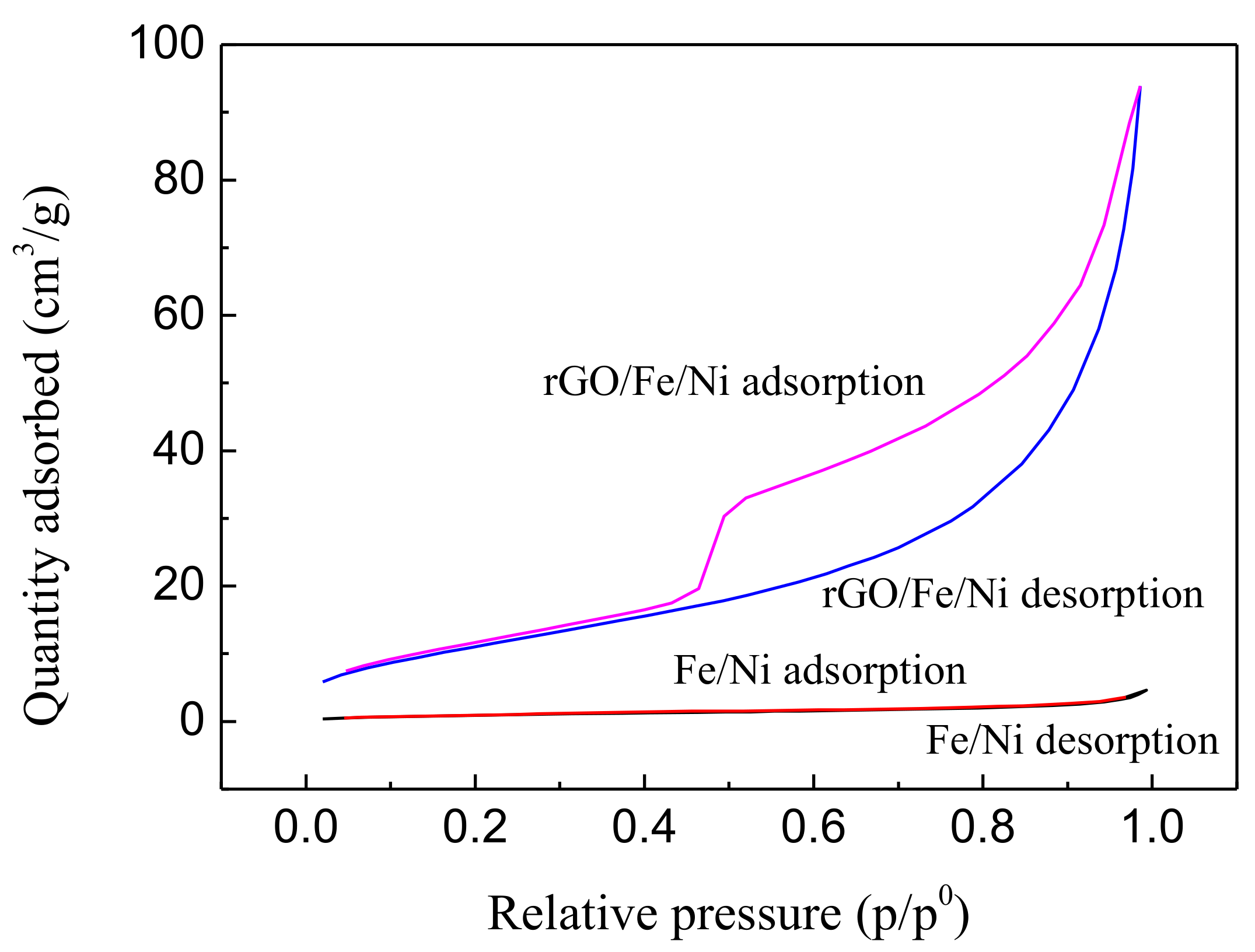


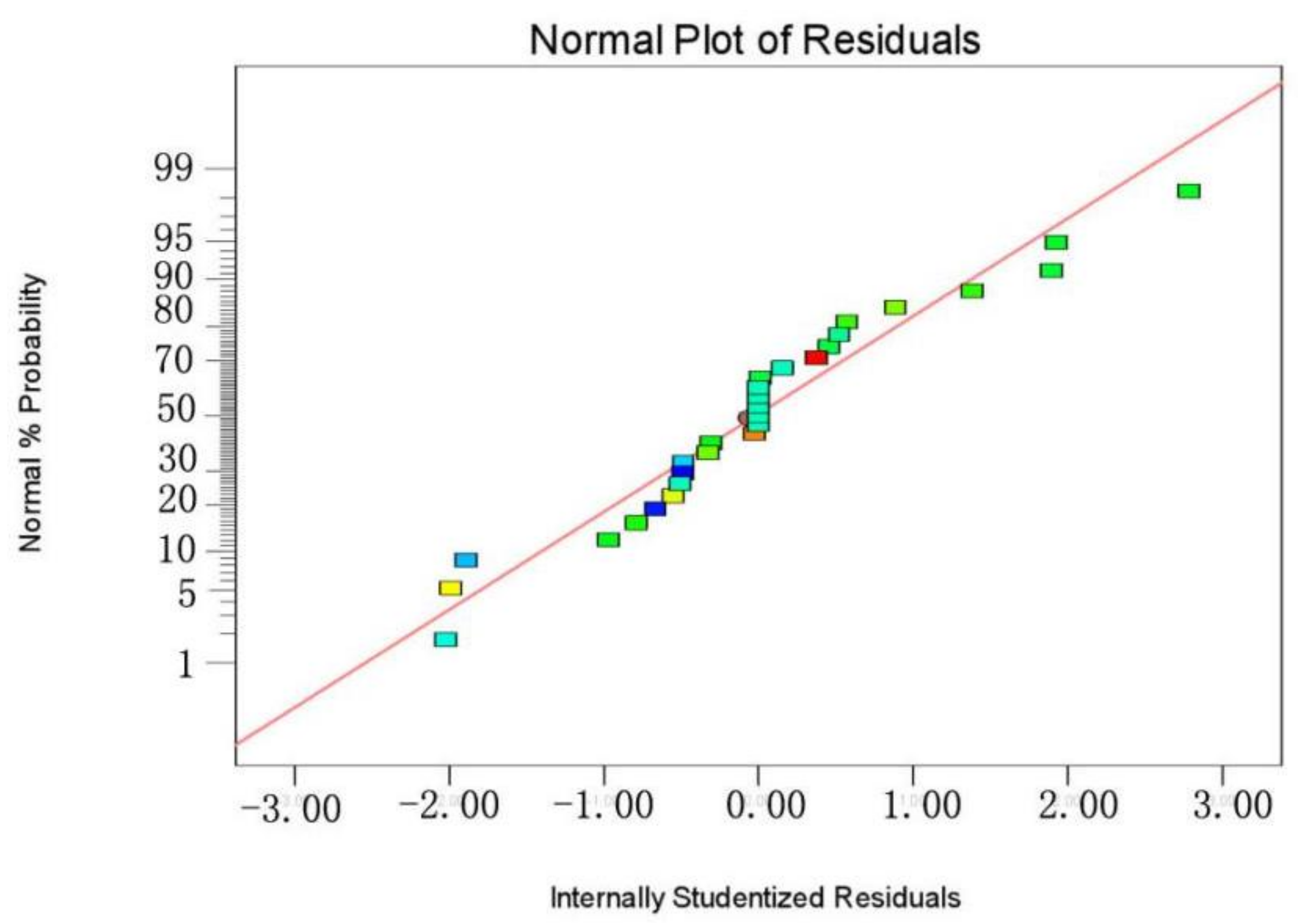

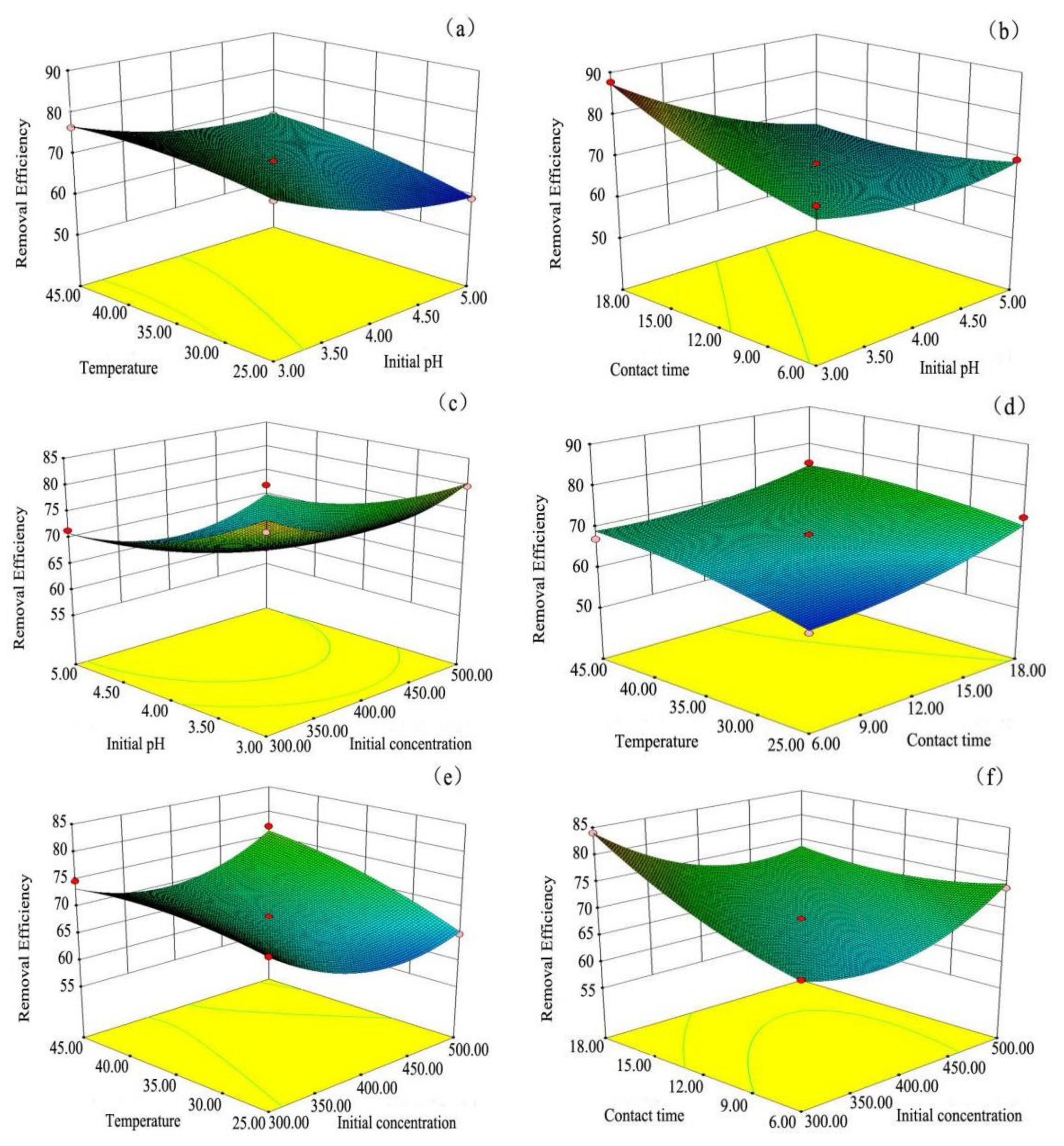
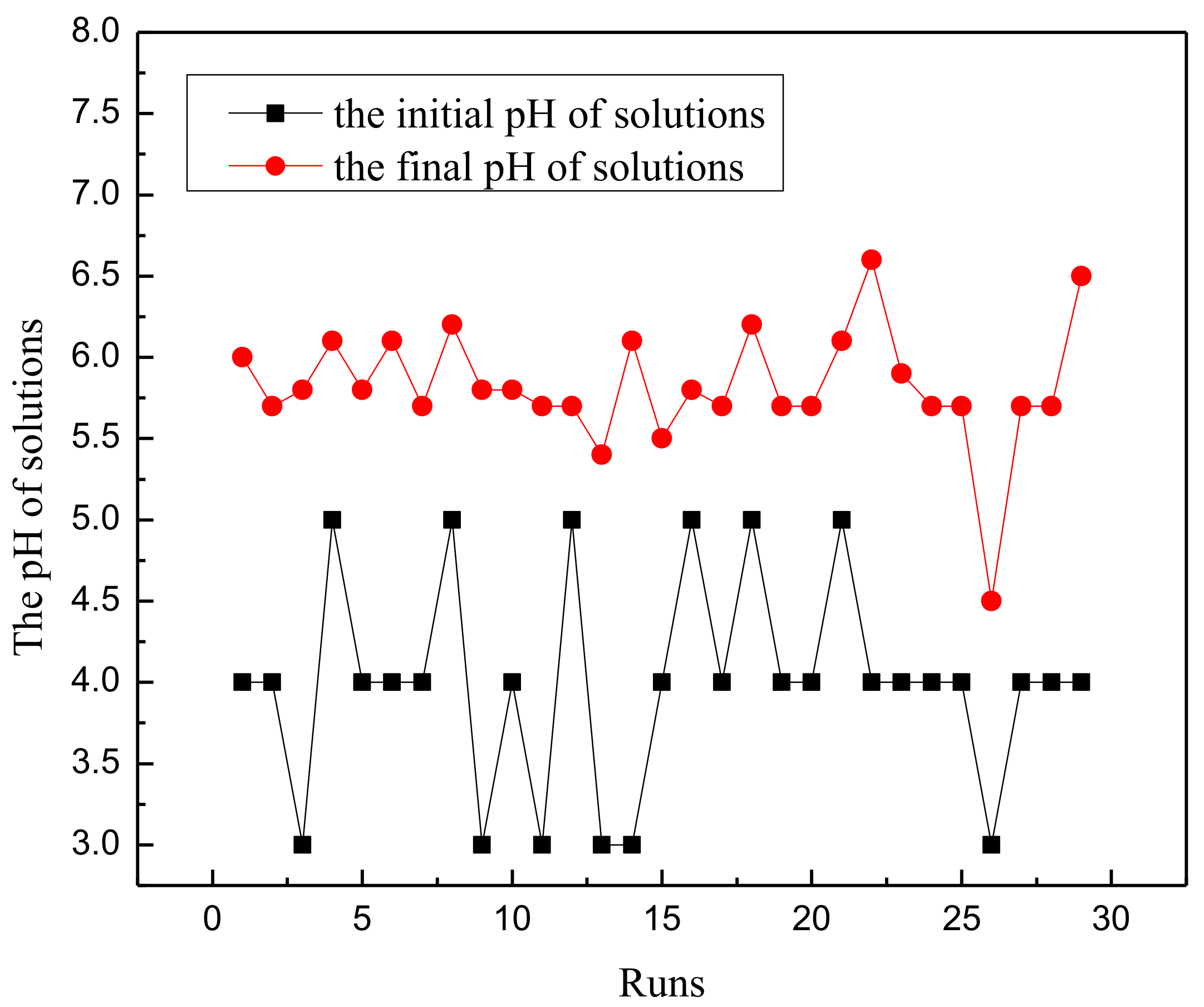




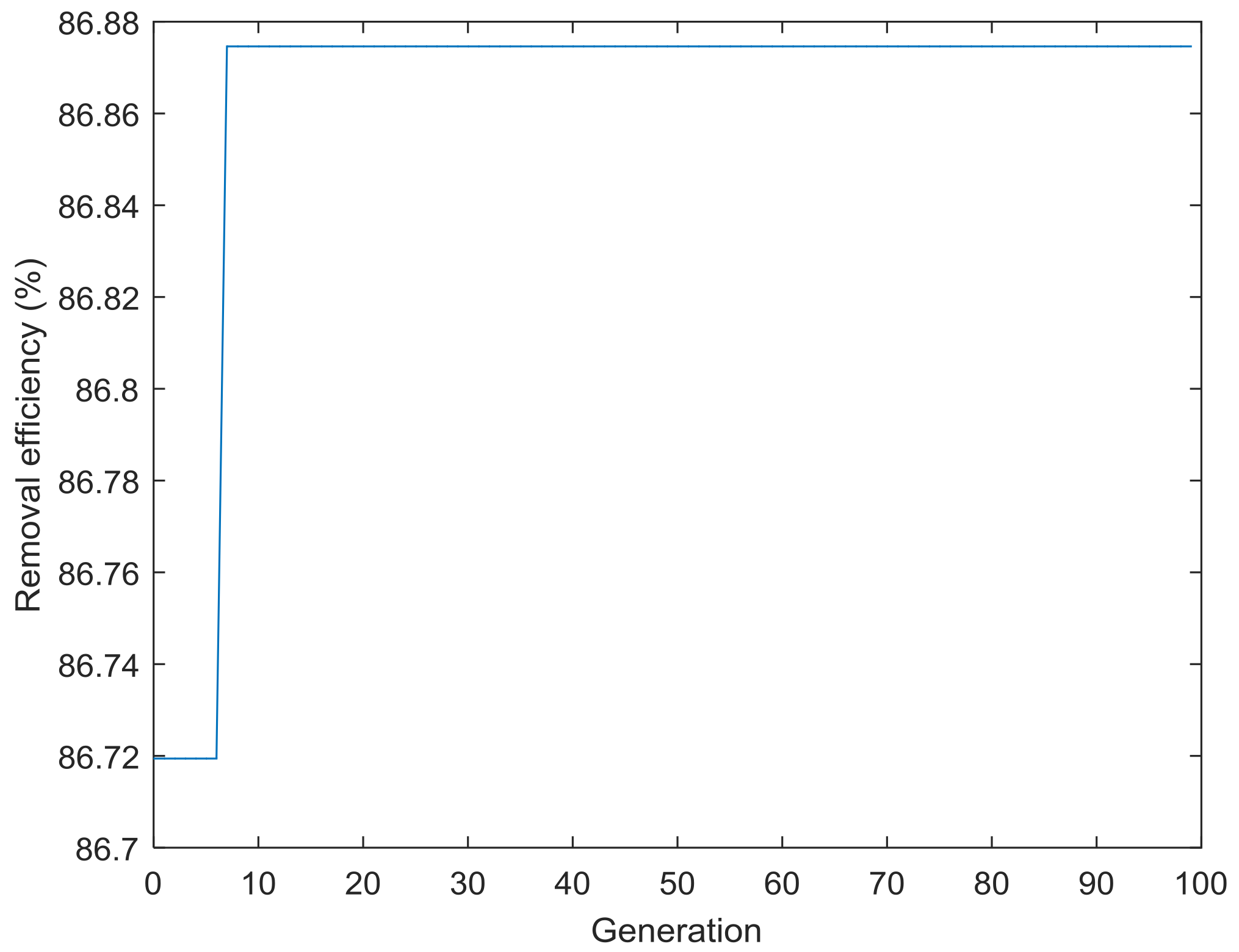
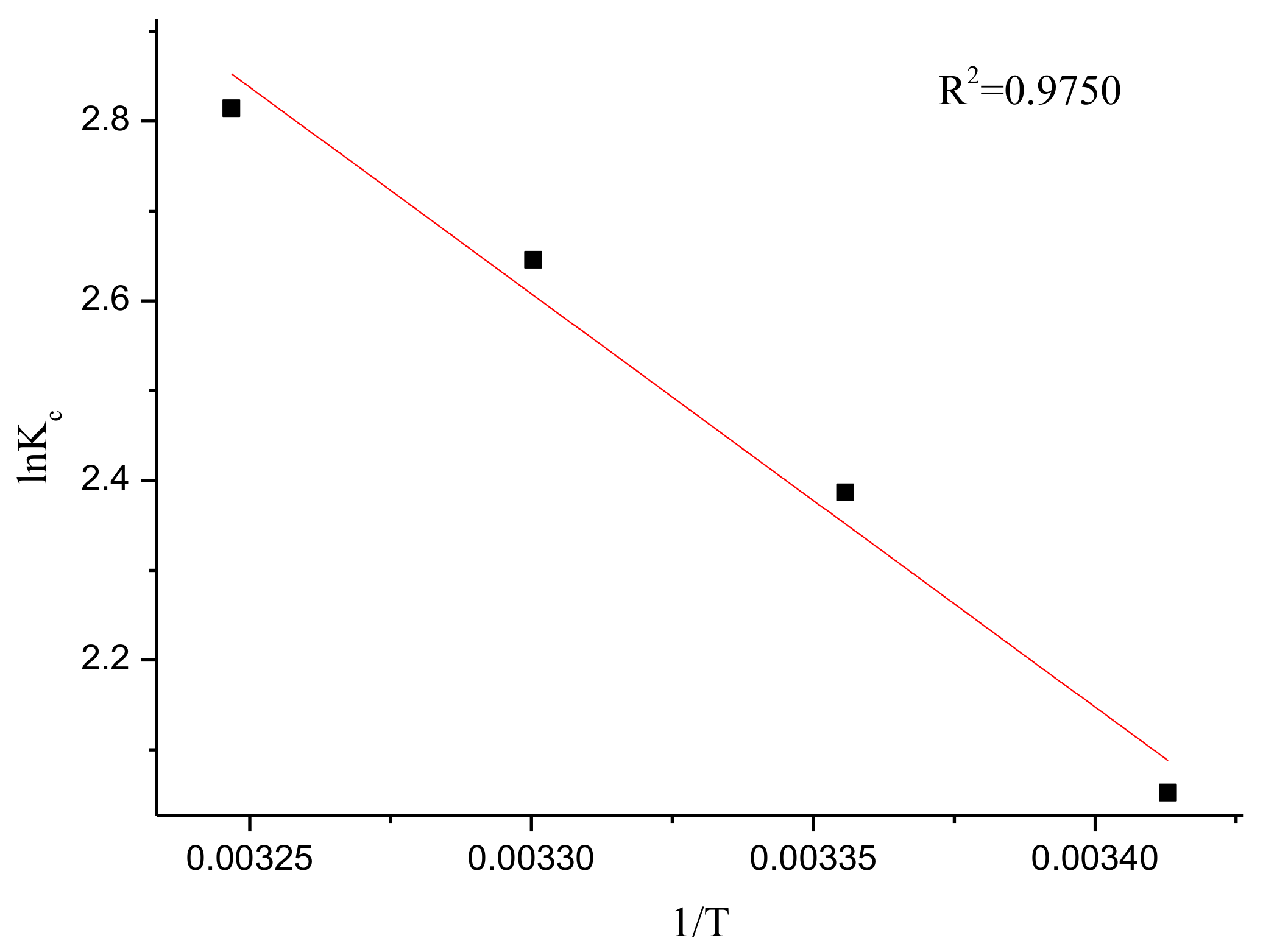
| Chemical Name | Crystal Violet |
|---|---|
| Molecular formula | C25H30N3Cl |
| Molecular weight | 408 g/mol |
| Maximum wavelength λ | 583 nm |
| Independent Variables | Factors | Levels | ||
|---|---|---|---|---|
| −1 | 0 | 1 | ||
| Initial dye concentration (mg/L) | X1 | 300 | 400 | 500 |
| Initial pH | X2 | 3 | 4 | 5 |
| Contact time (min) | X3 | 6 | 12 | 18 |
| Temperature (°C) | X4 | 25 | 35 | 45 |
| Run | X1 (mg/L) | X2 | X3 (min) | X4 (°C) | Actual (%) | Predicted (%) |
|---|---|---|---|---|---|---|
| 1 | 300 | 4 | 12 | 25 | 71.6 | 71.5 |
| 2 | 400 | 4 | 12 | 35 | 68.2 | 68.2 |
| 3 | 300 | 3 | 12 | 35 | 80.6 | 82.6 |
| 4 | 300 | 5 | 12 | 35 | 71.5 | 71.0 |
| 5 | 500 | 4 | 6 | 35 | 74 | 74.8 |
| 6 | 400 | 4 | 6 | 25 | 59.9 | 60.6 |
| 7 | 500 | 4 | 12 | 45 | 77.1 | 76.2 |
| 8 | 400 | 5 | 6 | 35 | 69.3 | 68.8 |
| 9 | 400 | 3 | 18 | 35 | 87.7 | 87.3 |
| 10 | 400 | 4 | 18 | 45 | 75 | 74.4 |
| 11 | 500 | 3 | 12 | 35 | 79.8 | 80.4 |
| 12 | 500 | 5 | 12 | 35 | 71.9 | 70.0 |
| 13 | 400 | 3 | 12 | 25 | 73 | 73.3 |
| 14 | 400 | 3 | 6 | 35 | 72.5 | 69.7 |
| 15 | 500 | 4 | 18 | 35 | 72.8 | 73.8 |
| 16 | 400 | 5 | 18 | 35 | 64.4 | 66.3 |
| 17 | 500 | 4 | 12 | 25 | 65 | 69.6 |
| 18 | 400 | 5 | 12 | 45 | 68.1 | 68.6 |
| 19 | 300 | 4 | 12 | 45 | 74.8 | 73.4 |
| 20 | 400 | 4 | 12 | 35 | 68.2 | 68.2 |
| 21 | 400 | 5 | 12 | 25 | 59.1 | 59.6 |
| 22 | 400 | 4 | 6 | 45 | 67.2 | 69.2 |
| 23 | 300 | 4 | 18 | 35 | 84 | 84.2 |
| 24 | 400 | 4 | 12 | 35 | 68.2 | 68.2 |
| 25 | 400 | 4 | 18 | 25 | 72.5 | 70.1 |
| 26 | 400 | 3 | 12 | 45 | 76.5 | 76.8 |
| 27 | 400 | 4 | 12 | 35 | 68.2 | 68.2 |
| 28 | 400 | 4 | 12 | 35 | 68.2 | 68.2 |
| 29 | 300 | 4 | 6 | 35 | 68 | 67.8 |
| Source | Sum of Squares | Degree of Freedom | Mean Square | F-Value | p-Value | |
|---|---|---|---|---|---|---|
| Model | 1110.15 | 14 | 79.30 | 32.49 | <0.0001 | Significant |
| X1 | 8.17 | 1 | 8.17 | 3.35 | 0.0887 | |
| X2 | 360.80 | 1 | 360.80 | 147.82 | <0.0001 | |
| X3 | 172.52 | 1 | 172.52 | 70.68 | <0.0001 | |
| X4 | 117.81 | 1 | 117.81 | 48.27 | <0.0001 | |
| X1X2 | 0.36 | 1 | 0.36 | 0.15 | 0.7067 | |
| X1X3 | 73.96 | 1 | 73.96 | 30.30 | <0.0001 | |
| X1X4 | 19.80 | 1 | 19.80 | 8.11 | 0.0129 | |
| X2X3 | 101.00 | 1 | 101.00 | 41.38 | <0.0001 | |
| X2X4 | 7.56 | 1 | 7.56 | 3.10 | 0.1002 | |
| X3X4 | 5.76 | 1 | 5.76 | 2.36 | 0.1468 | |
| X12 | 158.40 | 1 | 158.40 | 64.90 | <0.0001 | |
| X22 | 52.84 | 1 | 52.84 | 21.65 | 0.0004 | |
| X32 | 25.09 | 1 | 25.09 | 10.28 | 0.0063 | |
| X42 | 14.03 | 1 | 14.03 | 5.75 | 0.0310 | |
| Residual | 107.84 | 14 | 7.70 | - | - | |
| Lack of Fit | 107.84 | 10 | 10.78 | - | - | |
| Pure Error | 0 | 4 | 0 | - | - | |
| Total | 5777.37 | 28 | - | - | - |
| Runs | X1 (mg/L) | X2 | X3 (min) | X4 (°C) | Experimental Value (%) | Predicted Value (%) | Absolute Error (%) |
|---|---|---|---|---|---|---|---|
| 1 | 300 | 4 | 12 | 25 | 71.6 | 71.45 | 0.15 |
| 2 | 400 | 4 | 12 | 35 | 68.2 | 68.12 | 0.08 |
| 3 | 300 | 3 | 12 | 35 | 80.6 | 80.5 | 0.1 |
| 4 | 300 | 5 | 12 | 35 | 71.5 | 71.4 | 0.10 |
| 5 | 500 | 4 | 6 | 35 | 74 | 74.02 | 0.02 |
| 6 | 400 | 4 | 6 | 25 | 59.9 | 59.99 | 0.09 |
| 7 | 500 | 4 | 12 | 45 | 77.1 | 77.03 | 0.07 |
| 8 | 400 | 5 | 6 | 35 | 69.3 | 69.29 | 0.01 |
| 9 | 400 | 3 | 18 | 35 | 87.7 | 86.80 | 0.90 |
| 10 | 400 | 4 | 18 | 45 | 75 | 74.98 | 0.02 |
| 11 | 500 | 3 | 12 | 35 | 79.8 | 79.92 | 0.12 |
| 12 | 500 | 5 | 12 | 35 | 71.9 | 71.88 | 0.02 |
| 13 | 400 | 3 | 12 | 25 | 73 | 73.42 | 0.12 |
| 14 | 400 | 3 | 6 | 35 | 72.5 | 72.53 | 0.03 |
| 15 | 500 | 4 | 18 | 35 | 72.8 | 72.78 | 0.02 |
| 16 | 400 | 5 | 18 | 35 | 64.4 | 64.35 | 0.05 |
| 17 | 500 | 4 | 12 | 25 | 65 | 65.08 | 0.08 |
| 18 | 400 | 5 | 12 | 45 | 68.1 | 67.9 | 0.02 |
| 19 | 300 | 4 | 12 | 45 | 74.8 | 74.88 | 0.08 |
| 20 | 400 | 4 | 12 | 35 | 68.2 | 68.23 | 0.03 |
| 21 | 400 | 5 | 12 | 25 | 59.1 | 59.15 | 0.05 |
| 22 | 400 | 4 | 6 | 45 | 67.2 | 67.34 | 0.14 |
| 23 | 300 | 4 | 18 | 35 | 84 | 84.06 | 0.06 |
| 24 | 400 | 4 | 12 | 35 | 68.2 | 68.38 | 0.18 |
| 25 * | 400 | 4 | 18 | 25 | 72.5 | 72.49 | 0.01 |
| 26 * | 400 | 3 | 12 | 45 | 76.5 | 76.68 | 0.12 |
| 27 * | 400 | 4 | 12 | 35 | 68.2 | 68.16 | 0.04 |
| 28 * | 400 | 4 | 12 | 35 | 68.2 | 68.17 | 0.03 |
| 29 * | 300 | 4 | 6 | 35 | 68 | 67.03 | 0.03 |
| Mean absolute error (%) | 0.10 | ||||||
| Number of Neurons | wi | bi | wj | bj | |||
|---|---|---|---|---|---|---|---|
| Input Variables | |||||||
| Initial Dye Concentration | Initial pH | Contact Time | Temperature | ||||
| 1 | −0.05183 | 0.2899 | −1.9836 | −1.4754 | −2.4896 | −0.9964 | 0.2743 |
| 2 | 1.0057 | −0.04558 | 1.1144 | 1.9856 | 1.9363 | 0.4235 | |
| 3 | −1.4023 | −1.0854 | −1.7355 | 0.2040 | 1.3831 | 0.7355 | |
| 4 | −1.1128 | 1.92090 | −0.5651 | −0.975 | −0.8299 | −0.7634 | |
| 5 | 2.0220 | −1.3428 | −0.4420 | 0.3335 | 0.2766 | −0.9220 | |
| 6 | 0.3420 | 1.3265 | 1.4140 | 1.5239 | 0.2766 | 0.1964 | |
| 7 | −0.6076 | −1.4517 | −1.4871 | 1.2288 | −0.8299 | 0.2086 | |
| 8 | 1.9255 | −0.6918 | 1.4166 | −0.07202 | −1.3831 | 0.03286 | |
| 9 | 1.9083 | 1.1988 | −1.0214 | −0.2760 | 1.9363 | −0.9850 | |
| 10 | 0.7757 | −1.0114 | −1.3414 | −1.6655 | 2.4896 | 0.3779 | |
| Input Variables | Relative Significance (%) | Order |
|---|---|---|
| Initial dye concentration | 20.23% | 3 |
| Initial pH | 35.95% | 2 |
| Contact time | 7.54% | 4 |
| Temperature | 36.27% | 1 |
| Models | Independent Parameters | Prediction (%) | Experiment (%) | Absolute Error (%) | |||
|---|---|---|---|---|---|---|---|
| X1 | X2 | X3 | X4 | ||||
| BBD | 368.9 | 3.0 | 18.0 | 40.6 | 88.2 | 75.8 | 12.4 |
| ANN-PSO | 300.0 | 4.0 | 18.0 | 45.0 | 88.0 | 84.5 | 3.5 |
| ANN-GA | 331.2 | 3.3 | 15.8 | 36.1 | 86.9 | 81.3 | 5.6 |
| Isotherm Models | Parameters | Value of Parameters |
|---|---|---|
| Freundlich | Kf (mg/g) | 98.7 |
| 1/n | 0.4572 | |
| R2 | 0.9700 | |
| Langmuir | KL (L/mg) | 128.8 |
| qm (mg/g) | 2000.00 | |
| R2 | 0.9483 | |
| RL | 7.8 × 10−6–3.9 × 10−5 | |
| Temkin | A (L/g) | 0.089 |
| B | 402.97 | |
| R2 | 0.9094 | |
| Dubinin–Radushkevich | qm (mg/g) | 1350.4 |
| α (mol2/J2) | 1.0 × 10−3 | |
| E (kJ/mol) | 0.2 | |
| R2 | 0.7339 |
| Adsorbents | Maximum Adsorption Capacity (mg/g) | References |
|---|---|---|
| Chitosan–graphite oxide | 64.935 | [59] |
| NaOH-treated almond shell | 123 | [60] |
| Surfactant-modified alumina | 254 | [61] |
| Grafted polyacrylamide on SiO2 nanocomposites | 378.8 | [62] |
| Fe3O4/porous graphene | 460 | [63] |
| rGO/Fe/Ni composites | 2000 | This study |
| Kinetic Models | Parameters | Values of Parameters |
|---|---|---|
| Pseudo-first-order | k1 (1/min) | 0.18 |
| qe (mg/g) | 953.89 | |
| R2 | 0.9091 | |
| Pseudo-second-order | k2 (g/mg/min) | 2.0 × 10−3 |
| qe (mg/g) | 1111.11 | |
| R2 | 0.9946 | |
| Intraparticle diffusion | k3(mg/g/min1/2) | 128.04 |
| B (mg/g) | 364.18 | |
| R2 | 0.957 | |
| Elovich | α (mg/g/min) | 733.34 |
| β (g/mg) | 4.5 × 10−2 | |
| R2 | 0.9724 |
| K | ΔG0 (KJ/mol) | ΔS0 (kJ/mol/K) | ΔH0 (kJ/mol) |
|---|---|---|---|
| 293 | −5.0850 | 0.1480 | 38.2450 |
| 303 | −5.9120 | ||
| 313 | −6.5544 | ||
| 323 | −6.9719 |
© 2018 by the authors. Licensee MDPI, Basel, Switzerland. This article is an open access article distributed under the terms and conditions of the Creative Commons Attribution (CC BY) license (http://creativecommons.org/licenses/by/4.0/).
Share and Cite
Ruan, W.; Hu, J.; Qi, J.; Hou, Y.; Cao, R.; Wei, X. Removal of Crystal Violet by Using Reduced-Graphene-Oxide-Supported Bimetallic Fe/Ni Nanoparticles (rGO/Fe/Ni): Application of Artificial Intelligence Modeling for the Optimization Process. Materials 2018, 11, 865. https://doi.org/10.3390/ma11050865
Ruan W, Hu J, Qi J, Hou Y, Cao R, Wei X. Removal of Crystal Violet by Using Reduced-Graphene-Oxide-Supported Bimetallic Fe/Ni Nanoparticles (rGO/Fe/Ni): Application of Artificial Intelligence Modeling for the Optimization Process. Materials. 2018; 11(5):865. https://doi.org/10.3390/ma11050865
Chicago/Turabian StyleRuan, Wenqian, Jiwei Hu, Jimei Qi, Yu Hou, Rensheng Cao, and Xionghui Wei. 2018. "Removal of Crystal Violet by Using Reduced-Graphene-Oxide-Supported Bimetallic Fe/Ni Nanoparticles (rGO/Fe/Ni): Application of Artificial Intelligence Modeling for the Optimization Process" Materials 11, no. 5: 865. https://doi.org/10.3390/ma11050865
APA StyleRuan, W., Hu, J., Qi, J., Hou, Y., Cao, R., & Wei, X. (2018). Removal of Crystal Violet by Using Reduced-Graphene-Oxide-Supported Bimetallic Fe/Ni Nanoparticles (rGO/Fe/Ni): Application of Artificial Intelligence Modeling for the Optimization Process. Materials, 11(5), 865. https://doi.org/10.3390/ma11050865





